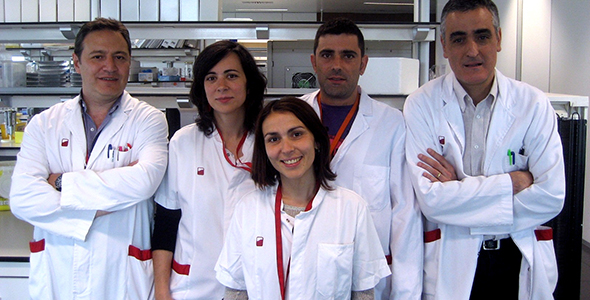Epidemiology, Pharmacology, New Therapies & Clinical Research
Molecular Diagnosis & Therapy
Francisco Vidal
Researchers Rafael Parra, Irene Corrales, Lluis Martorell, Carme Altisent | Researcher in training Nina Borras | Technician Lorena Ramírez, Natàlia Comes


Summary
Among the most important achievements of our group in 2015, we can highlight the in-deep analysis of the molecular study of all patients enrolled in the National Registry for Clinical and Molecular Profile of von Willebrand Disease in Spain (PCM-EVW-ES), a multicenter project that involves the largest Spanish hospitals and that recruited more than 550 patients suffering from different types of VWD. The application of the high-throughput NGS technology to perform the molecular diagnosis of a large cohort of patients is providing invaluable results for a powerful investigation in the pathophysiological mechanisms of VWD in correlation with molecular defects, shedding light on the complex genotype-phenotype relationship.
Furthermore, we have underway the development of the study awarded by the 2013 European ASPIRE Hemophilia Awards (Pfizer), entitled “Development of a high-throughput platform for Hemophilia A drug screening and gene correction using induced pluripotent stem cells (iPSCs) from patients”. The project is based on the technology developed and in the knowledge acquired during the progress of a European transnational coordinated project (HEMO-iPS) funded by E-Rare-2 (ERA-Net for Research on Rare Diseases). The overall objective is focused on the development of optimized molecular tools to perform functional studies related to the production, processing, secretion, and half-life of FVIII in disease-relevant cells from hemophilia patients.
Finally, the advent of NGS has opened the possibility to design custom protocols for molecular analysis of several genes in parallel. This approach is particularly valuable in the diagnosis of diseases with similar phenotype although caused by a heterogeneous molecular basis. Taking advantage of this novel opportunity, we designed custom panel to simultaneously analyze the 23 essential genes involved in inherited bleeding disorders. This versatile approach simplifies routine procedure and is especially helpful when clinical diagnosis was unclear or controversial due to a borderline phenotype with various candidate genes. The ultimate goal will be the integration of this data to refine the knowledge of genotype-phenotype correlation and improve the forecasting of hemorrhagic risk.
Publications
1
total
2.603
impact factor
2.603
average impact factor
Selected articles+
- Batlle, J., Perez-Rodriguez, A., Corrales, I., Lopez-Fernandez, M. F., Rodriguez-Trillo, A., Loures, E., et al. (2015). Molecular and clinical profile of von Willebrand disease in Spain (PCM-EVW-ES): Proposal for a new diagnostic paradigm. Thrombosis and Haemostasis, 114(6).
http://doi.org/10.1160/TH15-04-0282
- Martorell, L., Corrales, I., Ramirez, L., Parra, R., Raya, A., Barquinero, J., & Vidal, F. (2015). Molecular characterization of ten F8 splicing mutations in RNA isolated from patient’s leucocytes: assessment of in silico prediction tools accuracy. Haemophilia, 21(2), 249–257.
http://doi.org/10.1111/hae.12562
- Palomer, X., Capdevila-Busquets, E., Botteri, G., Davidson, M. M., Rodríguez, C., Martínez-González, J., et al. (2015). miR-146a targets c-Fos expression in human cardiac cells. Disease Models & Mechanisms, 8(9), 1081–1091.
http://doi.org/10.1242/dmm.020768
- Altisent, C., Martorell, M., Crespo, A., Casas, L., Torrents, C., & Parra, R. (2015). Early prophylaxis in children with severe haemophilia A: clinical and ultrasound imaging outcomes. Haemophilia, 22(2), 218–224.
http://doi.org/10.1111/hae.12792
- Villarrubia, R., Oyagüez, I., Alvárez-Román, M. T., Mingot-Castellano, M. E., Parra, R., & Casado, M. A. (2015). Cost analysis of prophylaxis with activated prothrombin complex concentrate vs. on-demand therapy with activated factor VII in severe haemophilia A patients with inhibitors, in Spain.
Haemophilia, 21(3), 320–329. http://doi.org/10.1111/hae.12681
[ View all publications ]
Main research projects
View+
- Aplicación de las nuevas tecnologías de secuenciación masiva al diagnóstico molecular de las coagulopatías congénitas.
FUNDING ORGANISATION: Instituto de Salud Carlos III
START DATE 2013 FINISH DATE 2015
PRINCIPAL RESEARCHER: Dr. Francisco Vidal
- Development of an efficient high-throughput platform for Hemophilia A drug screening and gene correction using patient-specific induced pluripotent stem cells (iPSCs).
FUNDING ORGANISATION: Pfizer (Pfizer European ASPIRE Awards)
START DATE 2013 FINISH DATE 2015
PRINCIPAL RESEARCHER: Dr. Rafael Parra
- Application of the next generation sequencing technologies to the genetic testing of a large cohort of VWD Spanish patients. H13-000845
FUNDING ORGANISATION: Baxter Healthcare Corporation (Baxter BioScience Grants)
START DATE 2013 FINISH DATE 2015
PRINCIPAL RESEARCHER: Dr. Francisco Vidal
- Use of patient-specific induced pluripotent stem cells to improve diagnosis and treatment of hemophilia A (HEMO-iPS)
FUNDING ORGANISATION: Instituto de Salud Carlos III, under the frame of E-Rare-2, the ERA-Net for Research on Rare Diseases.
START DATE 2012 FINISH DATE 2016
COORDINATOR: Dr. Jordi Barquinero.
PRINCIPAL RESEARCHER (Team 4): Dr. Francisco Vidal





